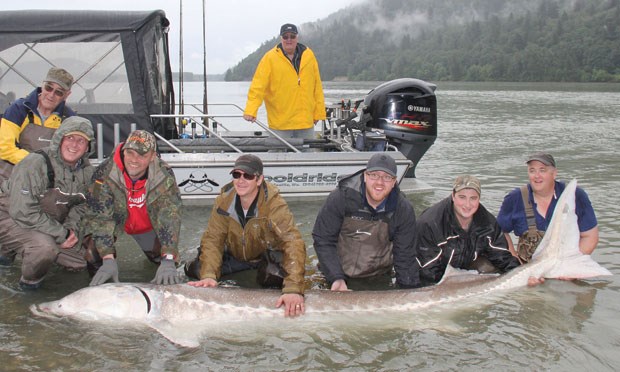An amazing fish lurks in the Fraser River: an ancient giant, the largest freshwater fish in North America.
The white sturgeon has a prehistoric look, with bony plates along its back instead of scales, a sweeping tail and long pointed head. It has changed little since its ancestors swam the earth's waters 175 million years ago.
Fraser sturgeon are adapted to fresh and salt water, migrating in and out of the river, and up and down the coast. Feeding in deep, fast water, mature sturgeon suck food from the river bottom; they can live to be 100 years old.
Fishing guide Steve Kaye recently helped his clients land a record white sturgeon in the Fraser at Chilliwack in a catch and release fishery.
The mega-fish measured 3.4 metres (more than 11 feet) and weighed about 340 kilograms (750 pounds). It was the biggest of the season, and the best of his career.
Kaye said increased catches of large sturgeon and noticeably more fish in the river over the last decade are making the Fraser a tourist destination for big game fishing. An average sturgeon is 1.5 to two metres long (five to seven feet) and 102 kilograms (225 pounds). Sturgeon have always been important to First Nations, who traditionally used long-handled spears to catch them in the Fraser. John Keast Lord, an English naturalist, wrote in 1858: "to spear and land a sturgeon five or six hundred pounds in weight with only a frail canoe... requires a degree of skill, courage and dexterity that only a lifetime's practice can bestow." The canoes went out at dawn during the spring freshet, when the "sturgeon are continually leaping" from the water.
Sturgeon Banks, Richmond, is where Captain George Vancouver purchased some from the Musqueam, and sturgeon were later traded at Fort Langley.
Even Kaye's big catch was smaller than historic sturgeon, like the 4.12-metre (13.5-foot), 411-kilogram (905-pound) giant caught in 1912 by Jim Burgess. Intensive commercial fishing from 1885 onwards rapidly decimated populations of these long-lived fish.
In 1994, low numbers and a die-off in the Fraser estuary led to a ban on harvesting. Loss and degradation of spawning and feeding habitat, poaching and warming river waters are continuing threats to sturgeon survival, although numbers are slowly recovering.
Kaye says it is the thrill and challenge of landing the giant fish that bring fishing enthusiasts from across the world, even though many Canadians are still unaware of the great white sturgeon's existence.
Anne Murray has written two guidebooks to Delta's natural and ecological history: A Nature Guide to Boundary Bay and Tracing Our Past, a Heritage Guide to Boundary Bay. Ask for them at local book stores or purchase online at www.natureguidesbc.com. Follow Anne on Twitter @natureguidesbc or on her blog: www.natureguidesbc.wordpress.com.



